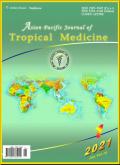Molecular evidence and phylogenetic delineation of spotted fever group Rickettsia species in Amblyomma ticks from cattle in Gauteng and Limpopo Provinces, South Africa
IF 1.6
4区 医学
Q3 PUBLIC, ENVIRONMENTAL & OCCUPATIONAL HEALTH
引用次数: 0
Abstract
To determine the prevalence of tick-borne pathogens with a particular focus on Rickettsia spp. in ticks collected from cattle in Gauteng and Limpopo Provinces, South Africa. A total of 200 ticks were collected from cattle within the Madala livestock, Pretoria, Gauteng Province and in Mankweng Township, Polokwane, Limpopo Province in 2019. The ticks were morphologically identified and processed individually for a total genomic DNA extraction. Specific primers targetting ompA, ompB, and the 17KDa genes were used for a molecular screening and delineation of Rickettsia from the extracted genetic materials using polymerase chain reaction (PCR) technique. PCR amplicons of positive samples were sequenced bidirectionally using the Sanger sequencing method. Sequences generated were processed and analysed using appropriate bioinformatics software. The ticks were morphologically identified as Amblyomma spp. PCR profiling of the genomic DNA samples revealed the presence of the Rickettsia pathogen in 42 (21%) of the ticks collected from both Provinces. Out of the genes profiled, 14 (7%) were positive for 17KDa, 42 (21%) for ompA and 32 (16%) were positive for ompB genes respectively. The nucleotide blast of the sequenced genomes showed high similarity, as high as 100% with other reference Rickettsia (R.) africae in the GenBank. The phylogenetic analysis of the sequences further validated them as R. africae with their characteristic clustering pattern with related reference sequences. There is an abundance of R. africae in Amblyomma ticks collected from cattle in the study areas. This has serious public health implications as individuals who accidentally get infested with the ticks could acquire R. africae. Hence, adequate precautions in terms of sensitization of farmers about the risk and mass mobilization drive to control the vectors in the areas are highly recommended to safeguard public health.南非豪登省和林波波省牛源肉芽肿蜱斑点热群立克次体的分子证据和系统发育描述
确定从南非豪登省和林波波省采集的牛蜱中蜱传病原体的流行情况,特别关注立克次体。2019年,在豪登省比勒陀利亚的Madala牲畜和林波波省Polokwane的mankeng镇的牛身上共收集到200只蜱虫。对蜱虫进行形态学鉴定,并单独处理以提取总基因组DNA。以ompA、ompB和17KDa基因为特异引物,利用聚合酶链反应(PCR)技术从提取的遗传物质中进行立克次体分子筛选和描述。阳性样品的PCR扩增子采用Sanger测序法进行双向测序。生成的序列使用适当的生物信息学软件进行处理和分析。两省采集的蜱中有42只(21%)携带立克次体致病菌。其中,14个(7%)基因为17KDa阳性,42个(21%)基因为ompA阳性,32个(16%)基因为ompB阳性。测序基因组的核苷酸blast与GenBank中其他参考立克次体(R.)非洲立克次体的相似性高达100%。系统发育分析表明,这些序列与相关参考序列具有典型的聚类模式,进一步证实了它们是非洲种。在研究区采集的牛蜱中有大量的非洲鼠。这具有严重的公共卫生影响,因为意外感染蜱虫的个人可能会感染非洲血吸虫。因此,强烈建议采取适当的预防措施,提高农民对风险的认识,并动员群众在这些地区控制病媒,以保障公众健康。
本文章由计算机程序翻译,如有差异,请以英文原文为准。
求助全文
约1分钟内获得全文
求助全文
来源期刊

Asian Pacific journal of tropical medicine
PUBLIC, ENVIRONMENTAL & OCCUPATIONAL HEALTH-TROPICAL MEDICINE
CiteScore
4.00
自引率
9.70%
发文量
1936
审稿时长
3-8 weeks
期刊介绍:
Asian Pacific Journal of Tropical Medicine (ISSN 1995-7645 CODEN: APJTB6), a publication of Editorial office of Hainan Medical University,is a peer-reviewed print + online Monthly journal. The journal''s full text is available online at http://www.apjtm.org/. The journal allows free access (Open Access) to its contents and permits authors to self-archive final accepted version of the articles on any OAI-compliant institutional / subject-based repository.
APJTM aims to provide an academic communicating platform for international physicians, medical scientists, allied health scientists and public health workers, especially those of the Asia-Pacific region and worldwide on tropical medicine, infectious diseases and public health, and to meet the growing challenges of understanding, preventing and controlling the dramatic global emergence and re-emergence of infectious diseases in the Asia-Pacific.
The journal is proud to have an international and diverse editorial board that will assist and facilitate the publication of articles that reflect a global view on tropical medicine, infectious diseases and public health, as well as emphasizing our focus on supporting the needs of public health practitioners. The APJTM will allow us to seek opportunities to work with others who share our aim, and to enhance our work through partnership, and to uphold the standards of our profession and contribute to its advancement.
 求助内容:
求助内容: 应助结果提醒方式:
应助结果提醒方式:


